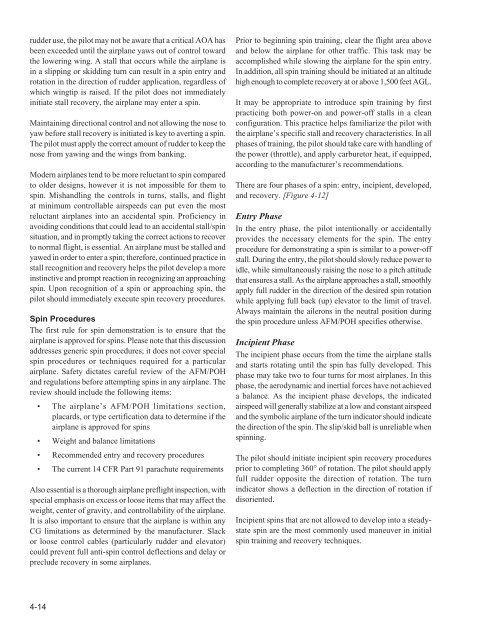You also want an ePaper? Increase the reach of your titles
YUMPU automatically turns print PDFs into web optimized ePapers that Google loves.
udder use, the pilot may not be aware that a critical AOA has<br />
been exceeded until the airplane yaws out of control toward<br />
the lowering wing. A stall that occurs while the airplane is<br />
in a slipping or skidding turn can result in a spin entry and<br />
rotation in the direction of rudder application, regardless of<br />
which wingtip is raised. If the pilot does not immediately<br />
initiate stall recovery, the airplane may enter a spin.<br />
Maintaining directional control and not allowing the nose to<br />
yaw before stall recovery is initiated is key to averting a spin.<br />
The pilot must apply the correct amount of rudder to keep the<br />
nose from yawing and the wings from banking.<br />
Modern airplanes tend to be more reluctant to spin compared<br />
to older designs, however it is not impossible for them to<br />
spin. Mishandling the controls in turns, stalls, and flight<br />
at minimum controllable airspeeds can put even the most<br />
reluctant airplanes into an accidental spin. Proficiency in<br />
avoiding conditions that could lead to an accidental stall/spin<br />
situation, and in promptly taking the correct actions to recover<br />
to normal flight, is essential. An airplane must be stalled and<br />
yawed in order to enter a spin; therefore, continued practice in<br />
stall recognition and recovery helps the pilot develop a more<br />
instinctive and prompt reaction in recognizing an approaching<br />
spin. Upon recognition of a spin or approaching spin, the<br />
pilot should immediately execute spin recovery procedures.<br />
Spin Procedures<br />
The first rule for spin demonstration is to ensure that the<br />
airplane is approved for spins. Please note that this discussion<br />
addresses generic spin procedures; it does not cover special<br />
spin procedures or techniques required for a particular<br />
airplane. Safety dictates careful review of the AFM/POH<br />
and regulations before attempting spins in any airplane. The<br />
review should include the following items:<br />
• The airplane’s AFM/POH limitations section,<br />
placards, or type certification data to determine if the<br />
airplane is approved for spins<br />
• Weight and balance limitations<br />
• Recommended entry and recovery procedures<br />
• The current 14 CFR Part 91 parachute requirements<br />
Also essential is a thorough airplane preflight inspection, with<br />
special emphasis on excess or loose items that may affect the<br />
weight, center of gravity, and controllability of the airplane.<br />
It is also important to ensure that the airplane is within any<br />
CG limitations as determined by the manufacturer. Slack<br />
or loose control cables (particularly rudder and elevator)<br />
could prevent full anti-spin control deflections and delay or<br />
preclude recovery in some airplanes.<br />
Prior to beginning spin training, clear the flight area above<br />
and below the airplane for other traffic. This task may be<br />
accomplished while slowing the airplane for the spin entry.<br />
In addition, all spin training should be initiated at an altitude<br />
high enough to complete recovery at or above 1,500 feet AGL.<br />
It may be appropriate to introduce spin training by first<br />
practicing both power-on and power-off stalls in a clean<br />
configuration. This practice helps familiarize the pilot with<br />
the airplane’s specific stall and recovery characteristics. In all<br />
phases of training, the pilot should take care with handling of<br />
the power (throttle), and apply carburetor heat, if equipped,<br />
according to the manufacturer’s recommendations.<br />
There are four phases of a spin: entry, incipient, developed,<br />
and recovery. [Figure 4-12]<br />
Entry Phase<br />
In the entry phase, the pilot intentionally or accidentally<br />
provides the necessary elements for the spin. The entry<br />
procedure for demonstrating a spin is similar to a power-off<br />
stall. During the entry, the pilot should slowly reduce power to<br />
idle, while simultaneously raising the nose to a pitch attitude<br />
that ensures a stall. As the airplane approaches a stall, smoothly<br />
apply full rudder in the direction of the desired spin rotation<br />
while applying full back (up) elevator to the limit of travel.<br />
Always maintain the ailerons in the neutral position during<br />
the spin procedure unless AFM/POH specifies otherwise.<br />
Incipient Phase<br />
The incipient phase occurs from the time the airplane stalls<br />
and starts rotating until the spin has fully developed. This<br />
phase may take two to four turns for most airplanes. In this<br />
phase, the aerodynamic and inertial forces have not achieved<br />
a balance. As the incipient phase develops, the indicated<br />
airspeed will generally stabilize at a low and constant airspeed<br />
and the symbolic airplane of the turn indicator should indicate<br />
the direction of the spin. The slip/skid ball is unreliable when<br />
spinning.<br />
The pilot should initiate incipient spin recovery procedures<br />
prior to completing 360° of rotation. The pilot should apply<br />
full rudder opposite the direction of rotation. The turn<br />
indicator shows a deflection in the direction of rotation if<br />
disoriented.<br />
Incipient spins that are not allowed to develop into a steadystate<br />
spin are the most commonly used maneuver in initial<br />
spin training and recovery techniques.<br />
4-14


